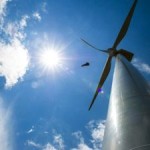
“The EU GHG Inventory Report shows that the European Union is well on track to meet its emission reduction targets with domestic policy measures only. Our policies and tools seem to be working,” said Professor Jacqueline McGlade, Executive Director of the European Environment Agency (EEA). “Although we are expecting an even sharper decline in 2009, caused mainly by the recession, we need to ensure that the downward trend in emissions continues and that Europe boosts its climate investments, with the ultimate aim of achieving a more resource-efficient economy.”
The combination of high coal and carbon prices accompanied by a drop in natural gas prices in 2008 induced heat and electricity producers to replace more polluting coal by gas and, as a result, reduce their GHG emissions. The use of biomass and other renewable sources (wind and hydroelectric power) has also increased significantly in 2008. The economic recession, which started during the second half of the year, also contributed to emission reductions from several sectors including the manufacturing and construction, and road transport sectors. Road transport emissions were also affected by high oil prices, the continued decline in gasoline consumption and a reversal of the upward trend in diesel sales.
The annual reductions for EU-15 and EU-27 revealed in the inventory report fall within the brackets of the 2008 preliminary estimates, publish by the Agency in August 2009.
Key Findings
- The EU-27’s emissions have been declining steadily since 2003 to reach 4 940 billion tonnes CO2 equivalents in 2008. Compared to the 2007 emissions, this represents a reduction of 99 million tonnes or 2%. With the 2008 emissions 11.3% below its 1990 levels, EU-27 has already achieved more than half of its unilateral reduction target of 20% by 2020 through domestic emission reductions alone.
- In this first year of the Kyoto Protocol’s commitment period, EU-15 cut its emissions by 76 million tonnes CO2 equivalents, corresponding to a drop of 1.9% from 2007. This brought the EU-15 emissions 6.9%, or 295 million tonnes, below Kyoto base-year levels, already in 2008, not accounting for carbon sinks and the use of Kyoto flexible mechanisms.
- For the first time since 1992, emissions from international aviation and maritime transport fell in EU-27, partly due to the economic recession. These two sectors account for about 5.9% of total greenhouse gas emissions in EU-27 but are not accounted for in relation to measuring progress towards Kyoto targets.
- Spain accounted for one third of the net reduction in EU-27, mainly due to a substantial replacement of coal by natural gas and a sharp decline in gasoline consumption in road transport, complemented by an increase in renewable energy generation.
- The EU Emission Trading Scheme (EU ETS) covered 43% of total EU-27 greenhouse gas emissions in 2008. In 2008, emission levels under the EU ETS were about 3% lower than 2007 levels. The recently publish 2009 EU ETS data reveals that verified emissions in 2009 decreased by 11.6% compared to 2008 levels, and reflects the impact of the economic recession.
What Next?
At the end of the summer 2010, the Agency will publish preliminary estimates for the 2009 total EU emissions. This will be followed in the autumn by more comprehensive reports analyzing emission trends, policy effectiveness and progress towards meeting the Kyoto and other EU emission targets.
Greenhouse Gas Emissions in Co2-Equivalents (Excluding Carbon Sinks) & Kyoto Protocol Targets for 2008–2012

Background on the Inventory Report
The EEA report, ‘Annual European Union Greenhouse Gas Inventory 1990–2008 and Inventory Report 2010’ was submitted to the Secretariat of the United Nations Framework Convention on Climate Change (UNFCCC) as the European Union’s official submission. The report was prepared on behalf of the European Commission (DG CLIMA) by the European Environment Agency (EEA) and its European Topic Centre for Air and Climate Change (ETC/ACC), with substantial input by the Joint Research Centre (JRC) and Eurostat.
The UNFCCC, with 194 Parties, is the parent treaty of the 1997 Kyoto Protocol. The ultimate objective is to achieve stabilization of greenhouse gas concentrations in the atmosphere at a level that would prevent dangerous anthropogenic interference with the climate system.
EU-27: Austria, Belgium, Bulgaria, Cyprus, Czech Republic, Denmark, Estonia, Finland, France, Germany, Greece, Hungary, Ireland, Italy, Latvia, Lithuania, Luxembourg, Malta, the Netherlands, Poland, Portugal, Romania, Slovakia, Slovenia, Spain, Sweden, the United Kingdom.
EU-15: Austria, Belgium, Denmark, Finland, France, Germany, Greece, Ireland, Italy, Luxembourg, the Netherlands, Portugal, Spain, Sweden, the United Kingdom.








